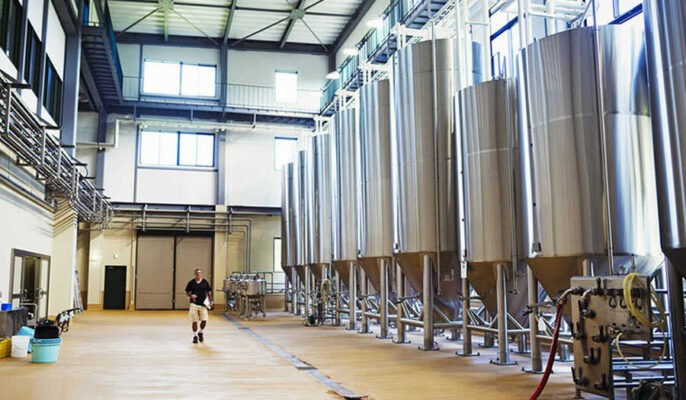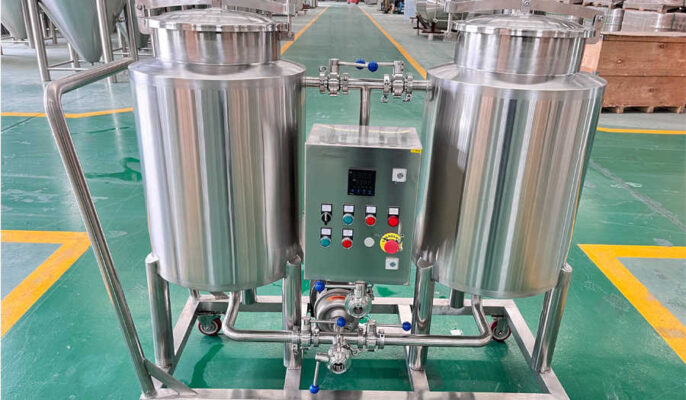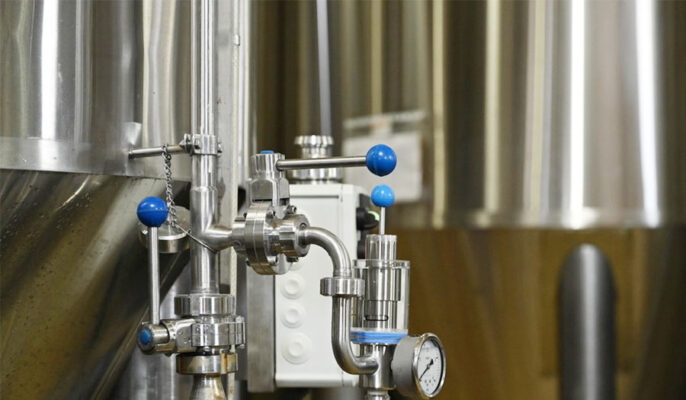Overview of Full Set Beer Brewing Equipment
A full set of beer brewing equipment contains all the necessary systems and components required to produce beer from start to finish. It enables complete control over the brewing process to create customized recipes and beer styles.
The equipment set includes modules for milling, mashing, lautering, boiling, fermenting, filtering, and transferring. Combined together in a brewery, these systems allow small-scale to large-scale commercial beer production ranging from microbreweries to industrial facilities.
Types of Full Set Beer Brewing Equipment
Full set brewing equipment is available in different configurations and levels of automation:
| Type | Description | Degree of Automation | Batch Size |
|---|---|---|---|
| Manual | Manually operated systems for mashing, boiling, fermenting. Basic controls. | Minimal | 1-5 BBL |
| Semi-automatic | Automated boiling, fermentation, CIP. Computerized sensors and control. | Moderate | 3-15 BBL |
| Fully automatic | Highly automated brewhouse and fermentation. Integrated monitoring and control. | High | 10-30+ BBL |
| Customized | Tailored combination of manual and automated systems. | Configurable | Application dependent |
The automation degree influences functionality, ease of operation, labor requirements, consistency and overall costs. Larger semi-auto and fully auto equipment target higher volume commercial and industrial breweries.

Key Equipment in Full Set Brewing Systems
A full set of brewing equipment contains the following major components:
- Milling – Roller mill, hammer mill
- Mashing – Mash tun, mixer
- Lautering – Lauter tun, grant
- Boiling – Brew kettle, whirlpool
- Fermentation – Fermenter, temperature control
- Filtration – Centrifuge, filter press
- Storage – Serving tanks, brite tanks
- Utilities – Steam system, cooling system, CIP, air compressor
- Controls – Sensors, transmitters, automation software
Additional equipment like grain handling, bottle filling, kegging, and more can be incorporated for a complete packaged solution.
Specifications of Full Set Beer Brewing Equipment
Technical specifications vary across full set brewing systems but typical parameters include:
| Parameter | Specification Range |
|---|---|
| Batch Size | 1-100 BBL |
| Mash Tun Capacity | 1.5 x batch size |
| Lauter Tun Capacity | 1-1.5 x batch size |
| Brew Kettle Size | 1-1.2 x batch size |
| Fermenter Size | 1-3 x batch size |
| Temperature Range | -10 to 150°C |
| Pressure Rating | -1 to 10 barg |
| Materials | Stainless steel (304, 316), alloy steel |
| Automation | Sensor-based monitoring and control |
| documentation | Design reports, operating manuals, training |
Key considerations for customized specifications are production scale, beer types, degree of automation, and quality standards.
Design Aspects for Full Set Beer Brewing Systems
Several design aspects must be incorporated when engineering full set brewing systems:
- Hygienic sanitary design per ASME BPE standard
- Jacketed kettles and tanks for heating/cooling
- Sloped vessels and smooth finishes for efficient drainage
- CIP spray balls and connections
- Modular configuration for flexibile expandability
- Lifting points, platforms, ladders, railings for ergonomics
- Validation of all instrumentation and automation
- Hazard analysis of electrical area classifications
- Compliance with applicable pressure vessel codes
- Robustness and ease of maintenance
- Operator-friendly HMI and control configuration
Careful attention to these aspects ensures high performance, long equipment life, safety, and efficient beer production.
Standards and Compliances for Beer Brewing Equipment
Full set brewing systems must comply with the following key standards:
- ASME Boiler and Pressure Vessel Code – Design and fabrication of pressure equipment
- ASME BPE – Sanitary design requirements
- 21 CFR 110 cGMP – Process hygiene requirements for food
- UL 508A – Electrical control panel design and safety
- ATEX Directive – For equipment used in explosive environments
- IEC 61508 – Functional safety of automation systems
- Regional standards – CE (Europe), GOST (Russia), DOSH (Malaysia)
Compliance ensures equipment safety, reliability, hygiene and product quality for commercial brewing applications.
Suppliers of Full Set Beer Brewing Equipment
There are many equipment vendors worldwide offering full set brewing systems. Some leading suppliers include:
| Company | Location | Batch Sizes | Offerings |
|---|---|---|---|
| JVNW | USA | 1-30 BBL | Manual to fully automatic |
| Specific Mechanical | Canada | 3-30 BBL | Custom engineered |
| GEA Group | Germany | 3-200 BBL | Fully automated |
| KS Engineering | China | 1-100 BBL | Cost-effective systems |
| Criveller | Italy | 1-50 BBL | High quality manual equipment |
| Rolec Prozess | Germany | 3-100 BBL | Mix of manual and automated |
When selecting a supplier, key factors are manufacturing capability, customization flexibility, automation expertise, and after-sales support.
Pricing for Full Set Beer Brewing Equipment
A full set of beer brewing equipment typically costs:
| Brewery Scale | Equipment Cost Range |
|---|---|
| Microbrewery – 3 BBL | $150,000 to $350,000 |
| Pub brewery – 10 BBL | $350,000 to $750,000 |
| Restaurant brewery – 20 BBL | $500,000 to $1.5 million |
| Production craft brewery – 30 BBL | $1 million to $3 million |
- Costs scale up exponentially beyond 10 BBL capacities.
- Degree of automation significantly affects costs.
- Import duties and freight costs can add 25-50% for imported systems.
- Installation, engineering, control software extra.
Used equipment can reduce investment by 40-60% but may carry higher maintenance costs. Leasing options are also available to spread out upfront costs.
Installation Guidelines for Beer Brewing Equipment
Proper installation is critical for full set beer brewing equipment:
- Install indoors inside temperature-controlled building.
- Ensure sufficient headspace between vessels and ceiling.
- Allow clearance for piping, ventilation, electrical, maintenance access.
- Flooring should be anti-slip epoxy or tiling graded for drainage.
- Foundation needs to withstand equipment loads and vibrations.
- Rigging gear like cranes or hoists needed for vessel placement.
- Utilities – electricity, water, steam – should be pre-installed at spec’d ratings.
- Boilers, chillers, air compressors located within acceptable distances.
- Control panels require separate climate-controlled enclosures.
- Once placed, equipment must be leveled, aligned, grouted before connections.
Taking care to meet installation specifications ensures proper equipment function and avoids safety issues.
Maintenance and Operation of Beer Brewing Systems
To sustain optimal performance, full set brewing equipment requires diligent maintenance:
- Daily visual inspections and cleanliness checks before starting brewing.
- Preventive maintenance schedule for motors, pumps, valves, sensors
- Periodic servicing of control instrumentation and automation
- Inspect tanks, vessels, gaskets, fittings for corrosion
- Verify gauges, meters, sensors are calibrated
- Check electrical grounding, area classifications
- Document all maintenance activities and issues
- For operation:
- Strictly follow SOPs for each batch
- Monitor process parameters and beer characteristics
- Fine-tune recipes and procedures to achieve desired taste and consistency
Thorough maintenance complemented by vigilant operation enables years of safe production and beer quality.

How to Select a Beer Brewing Equipment Vendor
Here are key tips for selecting a full set brewing system vendor:
- Review company history, installations, and client references
- Ensure vendor offer complete brewery engineering, not just equipment supply
- Vendor should understand local installation requirements
- Examine breadth of equipment and automation portfolio
- Look for modular designs for easy expansion later
- Evaluate after-sales service and technical support capabilities
- Ask about lead times for both delivery and after-sales support
- Review sample P&IDs, design documents, equipment manuals
- Clarify terms for commissioning, training, warranties, and maintenance contracts
- Understand capabilities for troubleshooting and upgrades after installation
- Consider geographic proximity of vendor for service logistics
Taking the time to thoroughly evaluate vendors on these criteria ensures the best long-term equipment performance and value.
Pros and Cons of Full Set Beer Brewing Systems
Advantages:
- Complete process control for recipe customization
- Flexibility to develop unique beer styles and flavors
- Scalable capacity through modular expansion
- Consistency and repeatability once tuned
- Faster and less labor-intensive than homebrewing
- Automation increases safety and minimizes effort
- Complete solution from a single vendor
Disadvantages:
- Higher startup investment costs
- Complex equipment requires skilled personnel
- Maintenance and servicing still required
- Tuning recipes and processes takes significant effort
- Large footprint, utilities required
- Limited flexibility compared to multiple standalone kettles
- Changeovers between beer types can be time-consuming
For commercial breweries seeking overall automation and streamlining at smaller scales, full set systems provide marked benefits. But they require diligence to operate and maintain.
Comparison of Manual vs Automated Brewing Systems
Manual and automated full set brewing equipment have the following tradeoffs:
| Parameter | Manual | Automated |
|---|---|---|
| Capital Cost | Lower | Higher |
| Operating Labor | Higher | Lower |
| Ease of Use | Challenging | Simpler |
| Process Control | Minimal | Maximum |
| Recipe Flexibility | Higher | Medium |
| Product Consistency | Variable | Excellent |
| Expansion Capability | Limited | High |
| Overall Productivity | Lower | Higher |
Manual systems appeal to brewers on tight budgets but require more hands-on labor. Automated systems boost consistency and productivity but carry steeper initial investment.

FAQ
What is the typical brewhouse efficiency for a 10 BBL automated system?
Typical lauter tun efficiency is around 65-80% for a properly designed and operated 10 BBL automated brewhouse. Yields can be maximized through an integrated mash filtration system.
What is the production rate of a 20 BBL fully automated brewhouse?
A peak production rate of around 45-60 BBL per day can be achieved with an efficient 20 BBL fully automated system depending on the number of fermentation tanks. Multiple 20 BBL batches can be produced in a day.
How much headspace should be provided above brewing vessels?
For access and cleaning, around 2 feet of headspace should be provided between the top of vessels like the mash tun or kettle and the brewhouse ceiling.
How often should calibration be conducted on sensors and transmitters?
Calibration of pressure, temperature, level and flow sensors should be conducted every 6 months at minimum according to manufacturer recommendations to maintain control accuracy.
What are the power requirements for a 30 BBL brewhouse?
The system would need around 150-250 kVA of power supply depending on the motors and degree of automation. Chillers, boiler and other utilities also require significant power.



